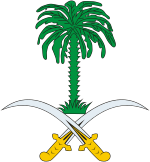Difference between revisions of "Abu Omar"
| Line 44: | Line 44: | ||
|} | |} | ||
| − | Abu Omar (Arabic: | + | Abu Omar (Arabic: أبو عمر , translated as 'Father of Omar.'), officially the Emirate of Abu Omar, is an emirate occupying a small section of the south coast on the Pellina island. It is bordered by Abu Hana to the east, Muhtaseb to the north and Haythamia to the north-west. The capital city is Ajaman (pronounced Arr-sha-maan). |
| + | |||
| + | == History == | ||
| − | |||
| − | |||
| − | |||
== Administrative divisions == | == Administrative divisions == | ||
| − | + | ||
== Economy == | == Economy == | ||
Revision as of 16:52, 24 April 2007
| The Emirate of Abu Omar | |
 |
|
| National flag | Coat of Arms |

| |
| Motto | Dominus illuminatio mea. |
| Capital | Ajaman |
| Languages - Official - Unofficial |
Arabic, English |
| Government Sultan - |
Mohammed ibn Al-Quuadi |
| Area |
183,885 km² 71,479 sq mi |
| Region | Saint Holden |
| Accession to Union of St Holden | 1934 |
| Population - Total (2007) |
19,000,000 |
| National animal |
Tiger |
| Currency | Rudolph |
| International abbreviation | ABO |
| Internet TLD | .aabo |
| Calling Code | +212 |
Abu Omar (Arabic: أبو عمر , translated as 'Father of Omar.'), officially the Emirate of Abu Omar, is an emirate occupying a small section of the south coast on the Pellina island. It is bordered by Abu Hana to the east, Muhtaseb to the north and Haythamia to the north-west. The capital city is Ajaman (pronounced Arr-sha-maan).
Contents
History
Administrative divisions
Economy
Before the discovery of oil the economy of the Abu Omari region focused on fishing and pearling. The discovery of oil reserves, beginning in the 1940s, completely transformed the nation's economy. Now the country has a high standard of living, with many social services offered to its citizens and all the amenities of any modern nation.
Abu Omar's national income primarily derives from oil and natural gas exports. The country has oil estimated at 55 billion barrels, while gas reserves in the giant north field which straddles the border with Abu Hana and are almost as large as the peninsula itself are estimated to be between 800-900tcf (Trillion Cubic Feet - 1tcf is equal to around 80 million barrels of oil equivalent).
Omaris' wealth and standard of living compare well with those of other nations; While oil and gas will probably remain the backbone of Abu Omar's economy for some time to come, the country seeks to stimulate the private sector and develop a "knowledge economy". Since the finding of oil the government has began various projects with the aim of attracting tourism and business.
Geography
Population
Culture
Abu Omar explicitly uses Wahhabi law as the basis of its government, and the vast majority of its citizens follow this specific Islamic doctrine. Wahhabism is a puritanical version of Islam which takes a literal interpretation of the Qur'an and the Sunnah. Wahhabism takes a more tolerant form in Abu Omar than in other puritanical Muslim nations.
Almost all Omarian women wear the black abaya; the government, however, does not impose the style universally. The abaya is mainly passed down from generation to generation and is still present because of the traditional values of the country.

